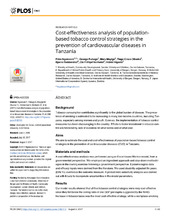| dc.contributor.author | Ngalesoni, Frida Namnyak | en_US |
| dc.contributor.author | Ruhago, Georg Mugambage | en_US |
| dc.contributor.author | Mayige, Mary T. | en_US |
| dc.contributor.author | Oliveira, Tiago Cravo | en_US |
| dc.contributor.author | Robberstad, Bjarne | en_US |
| dc.contributor.author | Norheim, Ole Frithjof | en_US |
| dc.contributor.author | Higashi, Hideki | en_US |
| dc.date.accessioned | 2018-08-21T11:57:56Z | |
| dc.date.available | 2018-08-21T11:57:56Z | |
| dc.date.issued | 2017-08-02 | |
| dc.Published | Ngalesoni F, Ruhago G, Mayige MT, Oliveira, Robberstad B, Norheim OF, Higashi H. Cost-effectiveness analysis of population-based tobacco control strategies in the prevention of cardiovascular diseases in Tanzania. PLoS ONE. 2017;12(8):e0182113 | eng |
| dc.identifier.issn | 1932-6203 | |
| dc.identifier.uri | https://hdl.handle.net/1956/18170 | |
| dc.description.abstract | Background: Tobacco consumption contributes significantly to the global burden of disease. The prevalence of smoking is estimated to be increasing in many low-income countries, including Tanzania, especially among women and youth. Even so, the implementation of tobacco control measures has been discouraging in the country. Efforts to foster investment in tobacco control are hindered by lack of evidence on what works and at what cost. Aims: We aim to estimate the cost and cost-effectiveness of population-based tobacco control strategies in the prevention of cardiovascular diseases (CVD) in Tanzania. Materials and methods: A cost-effectiveness analysis was performed using an Excel-based Markov model, from a governmental perspective. We employed an ingredient approach and step-down methodologies in the costing exercise following a government perspective. Epidemiological data and efficacy inputs were derived from the literature. We used disability-adjusted life years (DALYs) averted as the outcome measure. A probabilistic sensitivity analysis was carried out with Ersatz to incorporate uncertainties in the model parameters. Results: Our model results showed that all five tobacco control strategies were very cost-effective since they fell below the ceiling ratio of one GDP per capita suggested by the WHO. Increase in tobacco taxes was the most cost-effective strategy, while a workplace smoking ban was the least cost-effective option, with a cost-effectiveness ratio of USD 5 and USD 267, respectively. Conclusions: Even though all five interventions are deemed very cost-effective in the prevention of CVD in Tanzania, more research on budget impact analysis is required to further assess the government’s ability to implement these interventions. | en_US |
| dc.language.iso | eng | eng |
| dc.publisher | PLOS | eng |
| dc.rights | Attribution CC BY | eng |
| dc.rights.uri | http://creativecommons.org/licenses/by/4.0 | eng |
| dc.title | Cost-effectiveness analysis of population-based tobacco control strategies in the prevention of cardiovascular diseases in Tanzania | en_US |
| dc.type | Peer reviewed | |
| dc.type | Journal article | |
| dc.date.updated | 2018-03-07T13:21:23Z | |
| dc.description.version | publishedVersion | en_US |
| dc.rights.holder | Copyright 2017 The Author(s) | |
| dc.identifier.doi | https://doi.org/10.1371/journal.pone.0182113 | |
| dc.identifier.cristin | 1539466 | |
| dc.source.journal | PLoS ONE | |
| dc.relation.project | Norges forskningsråd: 218694 | |

